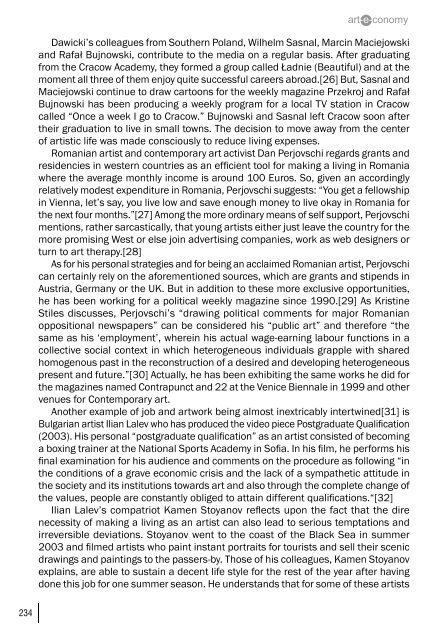art-e-conomy _ reader - marko stamenkovic
art-e-conomy _ reader - marko stamenkovic
art-e-conomy _ reader - marko stamenkovic
You also want an ePaper? Increase the reach of your titles
YUMPU automatically turns print PDFs into web optimized ePapers that Google loves.
234<br />
Dawicki’s colleagues from Southern Poland, Wilhelm Sasnal, Marcin Maciejowski<br />
and Rafał Bujnowski, contribute to the media on a regular basis. After graduating<br />
from the Cracow Academy, they formed a group called Ładnie (Beautiful) and at the<br />
moment all three of them enjoy quite successful careers abroad.[26] But, Sasnal and<br />
Maciejowski continue to draw c<strong>art</strong>oons for the weekly magazine Przekroj and Rafał<br />
Bujnowski has been producing a weekly program for a local TV station in Cracow<br />
called “Once a week I go to Cracow.” Bujnowski and Sasnal left Cracow soon after<br />
their graduation to live in small towns. The decision to move away from the center<br />
of <strong>art</strong>istic life was made consciously to reduce living expenses.<br />
Romanian <strong>art</strong>ist and contemporary <strong>art</strong> activist Dan Perjovschi regards grants and<br />
residencies in western countries as an efficient tool for making a living in Romania<br />
where the average monthly income is around 100 Euros. So, given an accordingly<br />
relatively modest expenditure in Romania, Perjovschi suggests: “You get a fellowship<br />
in Vienna, let’s say, you live low and save enough money to live okay in Romania for<br />
the next four months.”[27] Among the more ordinary means of self support, Perjovschi<br />
mentions, rather sarcastically, that young <strong>art</strong>ists either just leave the country for the<br />
more promising West or else join advertising companies, work as web designers or<br />
turn to <strong>art</strong> therapy.[28]<br />
As for his personal strategies and for being an acclaimed Romanian <strong>art</strong>ist, Perjovschi<br />
can certainly rely on the aforementioned sources, which are grants and stipends in<br />
Austria, Germany or the UK. But in addition to these more exclusive opportunities,<br />
he has been working for a political weekly magazine since 1990.[29] As Kristine<br />
Stiles discusses, Perjovschi’s “drawing political comments for major Romanian<br />
oppositional newspapers” can be considered his “public <strong>art</strong>” and therefore “the<br />
same as his ‘employment’, wherein his actual wage-earning labour functions in a<br />
collective social context in which heterogeneous individuals grapple with shared<br />
homogenous past in the reconstruction of a desired and developing heterogeneous<br />
present and future.”[30] Actually, he has been exhibiting the same works he did for<br />
the magazines named Contrapunct and 22 at the Venice Biennale in 1999 and other<br />
venues for Contemporary <strong>art</strong>.<br />
Another example of job and <strong>art</strong>work being almost inextricably intertwined[31] is<br />
Bulgarian <strong>art</strong>ist Ilian Lalev who has produced the video piece Postgraduate Qualification<br />
(2003). His personal “postgraduate qualification” as an <strong>art</strong>ist consisted of becoming<br />
a boxing trainer at the National Sports Academy in Sofia. In his film, he performs his<br />
final examination for his audience and comments on the procedure as following “in<br />
the conditions of a grave economic crisis and the lack of a sympathetic attitude in<br />
the society and its institutions towards <strong>art</strong> and also through the complete change of<br />
the values, people are constantly obliged to attain different qualifications.“[32]<br />
Ilian Lalev’s compatriot Kamen Stoyanov reflects upon the fact that the dire<br />
necessity of making a living as an <strong>art</strong>ist can also lead to serious temptations and<br />
irreversible deviations. Stoyanov went to the coast of the Black Sea in summer<br />
2003 and filmed <strong>art</strong>ists who paint instant portraits for tourists and sell their scenic<br />
drawings and paintings to the passers-by. Those of his colleagues, Kamen Stoyanov<br />
explains, are able to sustain a decent life style for the rest of the year after having<br />
done this job for one summer season. He understands that for some of these <strong>art</strong>ists


